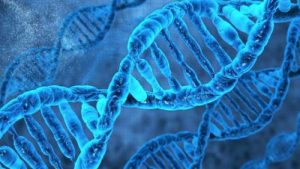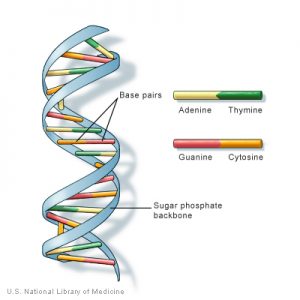Controversial theories of human origins,
mixed with a measure of coincidence,
and sprinkled with prose and fantasy.
Is DNA really a recent discovery?

Now that they claim that the human genome project is completed, it may take a while for the “smoke to clear”, or as some conspiracy theorists may suggest, “for the evidence to be hidden”.
It seems that there are some few genes in our code that don’t appear in anything else on the planet. One report says 223, the other says 40. To be fair, one of the solutions presented are that we may have been changed by bacterial infection. However, not all of the discrepancies are present in bacteria, their presence in our genome explained by symbiotic lateral transfer from the bacteria within our bodies. If those remaining genes did not evolve on earth, how did they get in us? The implications are that evolution is only partly responsible for our apparent intelligience and domination of this little rock. Another is that this proof that has been anticipated by Intelligient Designers that “God” created us by modifying our genes.
I have a problem with both assumptions: If bacterial infection could change our genetic structure, then we could not possibly be safe from this change repeatedly in short periods of time. We would all be mutants, hardly similar to our own family members.
On the other hand, if an omnipotent “God” created us, there would be no need to “modify” anything earthly to perform the feat.
My question is this: Is there any natural way that we could have received these genes? How about a method that doesn’t depend on either cross-bacterial osmosis or god? What if god used technology that clearly is possible (because we have figured it out)? Does that make him less of a god?
To that end, I think it is no accident that the ancient symbol of the medical profession is the rod of Asclepius, which is strangely reminiscent of an only recently discovered strand of DNA. It is also no accident that the human race was also subjected to numerous genetic bottlenecks, which evidence looks suspiciously like a breeding program.

Asclepius
A genetic bottleneck is where a significant population of a species of animals is killed or otherwise prevented from reproducing. This reduces the genetic diversity of the species overall from that point onward. Even if the numbers bounce back, we can show evidence of the past bottleneck by the lack of significant variation in size, structure, or coloring.
A very good example is that of the cheetah, whose current population shows so little genetic variation that not only are they almost exactly alike, their reproduction capacity is diminished; reducing their population in the long run, and as a result they suffer from all of the same conditions and diseases which have contributed to the result that the Cheetah becomes an endangered species.
Inbreeding is another possible explanation for this, but in that case, it is essentially a “breeding” program forced by family rules and justifications. In the example of royalty throughout the ages, it is a phenomenon that is kept from the common people, which makes this sort of thing easier to track separately.

The population of humans is increasing. However, there is evidence suggesting that the human population underwent one or more bottlenecks before and after 200,000 years ago because our overall genetic diversity is relatively low for the population size.
A study, by Tomàs Marquès Bonet, who is a researcher at the Institute of Evolutionary Biology in Barcelona, and Evan Eichler, of Washington University in Seattle WA, focused on including the greatest genetic diversity of wild specimens possible. They concluded that the great apes such as chimpanzees, gorillas, and orangutans form the closest group of living species to humans. We share a common ancestor who lived approximately 14-16 million years ago, and they concentrated on chimpanzees because we share a far more recent predecessor with them from six million years ago.
Compared to the genome of most of the great apes, human genomes show a greatly reduced variety. Few species of apes display such low levels. “This reduction in genetic diversity is normally the result of a process known as “population bottleneck”, characterized by a drastic decrease in the number of individuals in the population”, Javier Prado-Martínez, doctoral student at the Institute of Evolutionary Biology and one of the co-authors of the study suggested.
“What is surprising is the intensity of this bottleneck in human beings compared to most great apes. The genomes of a pair of orangutans, for example, differ in more than in more than 2 of every 1,000 base pairs, compared to 1 in every 1,000 base pairs between two humans”.
According to Wikipedia, humans are 0.5% different than any other humans, while chimpanzees are 2.7% different from one another. Homo sapiens evolved into modern humans solely in Africa, 200,000 to 100,000 years ago. Around that time, one African subpopulation of hominins among several became the ancestors of all human beings today. Despite the fact that when humans came out of Africa, they are only a fraction of a percent different than those who stayed. You have to ask why? Could the difference be attributed to Neanderthal genes added in while they were gone? OK, but the larger question remains, why no more than that? Both the missing link and the genetic bottleneck, combined with the discovery of genes that have no origin anywhere on Earth, and collaboration of mankind’s formation by the gods told by nearly every religion and many legends, give circumstantial evidence that our DNA was manipulated during this time by our gods of old.

Why did the hardier, stronger Neanderthal man go extinct while modern man flourished at a time when no other species were going extinct? Why do we have little hair on our bodies, unlike all other great apes to which we are very closely related? How can we have exactly the same mental capacity today as we did 30,000 years ago, but have only decided to use it for something other than food gathering over the last 4,000 years? These questions refuse to be answered by our current system of science.
Posted on March 17, 2008 on 11:31 am | In AA_Theory, Artifacts, Genetics, History | 9 Comments9 Comments »
RSS feed for comments on this post.
Leave a comment
 Entries and comments feeds.
Valid XHTML and CSS. ^Top^
Entries and comments feeds.
Valid XHTML and CSS. ^Top^
75 queries. 1.197 seconds.
Powered by WordPress design by John Doe.
Hello: The ancient symbol for the medical profession is the Rod of Asclepius, not the Caduceus, which usage is an American Army mistake only about 100 years old. See: http://en.wikipedia.org/wiki/Rod_of_Asclepius
Comment by Sid — August 1, 2008 #
Great link Sid,
It seems that it has been quite easy to mistake the relationship between these two symbols with apparently somewhat different meanings.
After digging into the link you provide, I think the Cadeuseus is totally appropriate for a military medic operation, due to the connotations of death and such. However, there are still ties with the tree of life in the garden of Eden, and the association with persuasion and evil which makes me think the story of Enki/Enlil and Prometheus are still associated with both symbols (hence with the technology of DNA manipulation) in some way.
Comment by Admin — August 2, 2008 #
This is strikingly similar to the argument I have with friends when anyone will listen to me rant. I’ve always maintained that it would be impossible for us to be on the planet for millenia and then suddenly, POOF! Intelligence and cognizance. I think we’ve been recently manipulated again, which is part of the reason we went from using oil burning lamps to using supercomputers in a single century (ok, century and a half, but the idea is still valid.) Not only have we most likely recently been tampered with, we are also most likely gaining from extraterrestrial technologies.
I do have a question, though. I’m not familiar with Enki or Enlil, though I enjoyed reading your writings concerning them. Where did those references originate from?
Comment by Eyrisahn — April 25, 2009 #
Enki and Enlil are gods of the Sumerian pantheon. They are probably THE two most active gods when it comes to interacting with humans. Enki is the Sumerian name for the Greek Titan Prometheus, the Serpent in the Garden, and the christian Satan, while Enlil goes on to be called Zeus, and the Hebrew god YWH. They are brothers, one born to rule the earth and the other to rule the skies. One was very kind to humans (even donated his own DNA) and gave us fire and technology to help us to progress, but the other insisted in using us and being worshipped by us. Can you guess which is which?
Comment by Admin — April 25, 2009 #
Amazing. I’m only just learning about all of the history involved in AAT and learning the various theories – could you quote some specific resources for additional research? Anything that you’d specifically recommend?
Comment by Eyrisahn — May 3, 2009 #
Do you think there is anything to the theories about rh- blood types? Possibly differences in genetics? Some of the things I have read sound pretty scary!
Comment by Donna — May 7, 2009 #
Considering it is likely that differences in genetics make for different blood types and not the other way around, I think that the differing blood types in concert with the different genetic haplogroups can be used as clues to unravel the question of which changes in our genes may have been due to natural selection, and which may have been direct tampering or even breeding by the “gods” in times past. Remember, the appearance of humans overall do not lend one to believe we were designed to be prey, nor predators. we have little hair, lack in strength, and are generally pretty delicate, compared to those we were supposed to evolve from (almost aquatic). So, I would guess a breeding program (genetic bottleneck) would have made us capable of higher thought at the expense of our survival characteristics. Not sure what natural selection scenario would lend itself to that…
Comment by Admin — May 8, 2009 #
Er zit nog een fout in. Een DNA-helix is altijd rechts draaiend, maar de afbeelding bij deze tekst laat een links draaiende DNA-helix zien.
There is still an error. A DNA helix is always running right, but the image in this text shows a left-handed DNA helix-see.
Comment by Tom — September 20, 2009 #
Thanks Tom,
I didn’t know that, however I am not the artist so I will look for a better image.
-Jeff
Comment by Jeff — November 11, 2009 #